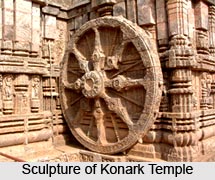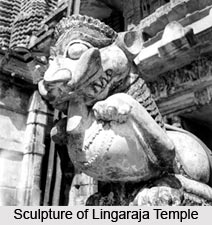 Temple sculptures of Odisha are famous for beautiful and explicit artistry. The sculptures of Konark temple is a good example. Many of the sculptural scenes are taken from religious mythology and legends; many represent military and courtly life; many represent activities which would have been associated with the temple. The refinement of the sculptor`s technique is combined with a vigorous quality. The images have been portrayed with a gentle lyricism, and a feeling which approaches tenderness. They are eloquent reminders of the brilliancy of Indian art.
Temple sculptures of Odisha are famous for beautiful and explicit artistry. The sculptures of Konark temple is a good example. Many of the sculptural scenes are taken from religious mythology and legends; many represent military and courtly life; many represent activities which would have been associated with the temple. The refinement of the sculptor`s technique is combined with a vigorous quality. The images have been portrayed with a gentle lyricism, and a feeling which approaches tenderness. They are eloquent reminders of the brilliancy of Indian art.
Buddhist Temple Sculpture of Odisha
The Buddhist sculptural art developed during the rule Emperor Ashoka from 261 BC to about 12th Century AD. Sculptures representing Boddhisatva and Avalokiteswara in different forms along with Buddha images, stupas and monasteries were the main constituent of the early medieval Odishan sculptural art. There are sculptures pertaining to various sects of Hinduism in Odisha, Shaivism, Vaishnavism and Shaktism (represented by Durga and her different forms). The Sailodbhava, the Bhaumakaras, the Somavansis and the illustrious Gangas are known for temple building. The sculptures and superb carvings on the temples at Bhubaneshwar, Puri and Konark are the finest examples of the Odisha`s glorious past.
Features of Temple Sculpture of Odisha
The temple sculptures are of two categories: the cult image and the decorative motifs.  The first category includes such images as Ganesha, Kartikeya and Durga on the external walls of a Shiva temple Varaha, Trivikra Nrusimha and-the ten avataras on the outer walls on a Vishnu temple, the Dikpalas. Religious synthesis is reflected through these images. The sculptures of nayika and mithuna figures, yakshas and yakhis (the male and female deities associated with ancient fertility cults), heavenly musicians, human poses and expressions, elephants, horses and soldiers and those depicting day to day themes, like hunting, dancing, games and family life are worth mentioning here. Post the fall of the Gangas, sculpture in Odisha vanished as an art form. Konark temple was built during the rule of Eastern Ganga dynasty. Every part of the temple is covered with sculpture.
The first category includes such images as Ganesha, Kartikeya and Durga on the external walls of a Shiva temple Varaha, Trivikra Nrusimha and-the ten avataras on the outer walls on a Vishnu temple, the Dikpalas. Religious synthesis is reflected through these images. The sculptures of nayika and mithuna figures, yakshas and yakhis (the male and female deities associated with ancient fertility cults), heavenly musicians, human poses and expressions, elephants, horses and soldiers and those depicting day to day themes, like hunting, dancing, games and family life are worth mentioning here. Post the fall of the Gangas, sculpture in Odisha vanished as an art form. Konark temple was built during the rule of Eastern Ganga dynasty. Every part of the temple is covered with sculpture.
Rajarani Temple is a temple that was built in the eleventh century. The temple has erotic carvings of women. Its sculptures have depth. Mukteswara temple and Lingaraja temple of Bhubaneshwar is also known for its sculpture. The sculptured gateway, the Jagamohana with diamond shaped latticed windows and decorated interiors and the plethora of sculptural work deserve mention. The sculptures in the ceiling of the Jagamohan are an entirely different creation. Sculptures can be found of elephants, monkeys, lions and other animals.



















